
EUROPEAN PHYSICAL JOURNAL E
metrics 2024
Pioneering research for a healthier, sustainable future.
Introduction
EUROPEAN PHYSICAL JOURNAL E, published by Springer, is a vital platform for researchers and professionals in the multidisciplinary fields of Biophysics, Biotechnology, Chemistry, Materials Science, and Medicine. With a focus on innovative research and developments from 2000 to 2024, this journal not only contributes to advancing knowledge but also provides insights into a wide array of applications in scientific and industrial sectors. Although it does not currently offer open access, its rigorous peer-review process ensures high-quality publications. With a 2023 impact factor ranking it in the third quartile across various relevant categories, including Q2 in Chemistry (miscellaneous), it stands as a credible source for emerging researchers and established scientists alike. The journal aims to foster collaboration and interdisciplinary research, making it an essential resource for anyone interested in the latest advancements across these interconnected fields.
Metrics 2024
 0.40
0.40 1.80
1.80 1.60
1.60 102
102Metrics History
Rank 2024
Scopus
IF (Web Of Science)
JCI (Web Of Science)
Quartile History
Similar Journals

European Physical Journal-Special Topics
Illuminating Topical Issues with Cutting-edge ResearchThe European Physical Journal-Special Topics (EPJ ST), published by Springer Heidelberg, is an esteemed academic journal dedicated to the dissemination of high-quality research across various domains of physics and materials science. With an ISSN of 1951-6355 and E-ISSN 1951-6401, it serves as a platform for articles that delve into topical issues and emerging areas of interest. The journal consistently ranks in the upper quartiles of its categories, achieving Q2 in Materials Science, Q3 in Physical and Theoretical Chemistry, and Q2 in Physics and Astronomy for 2023. This underscores its significant impact in these fields, positioned well within percentile rankings that reflect its relevance and esteem among peers. With an impressive convergence from 2007 to 2024, EPJ ST not only contributes to theoretical advancements but also promotes collaborative research through its open-access options. Ultimately, it serves as an essential resource for researchers, professionals, and students pursuing innovative insights and advancements in physics and materials science.
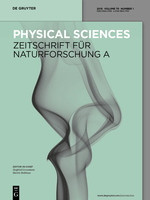
ZEITSCHRIFT FUR NATURFORSCHUNG SECTION A-A JOURNAL OF PHYSICAL SCIENCES
Advancing the Frontiers of Physical SciencesZEITSCHRIFT FUR NATURFORSCHUNG SECTION A - A JOURNAL OF PHYSICAL SCIENCES is a distinguished journal published by Walter de Gruyter GmbH, based in Germany, that serves as a vital platform for research in the realms of mathematical physics, physical and theoretical chemistry, and broader disciplines within physics and astronomy. Established in 1946, this journal has been a cornerstone for scientists and researchers, providing rigorous peer-reviewed articles that push the boundaries of knowledge in physical sciences. With a notable 2023 Scopus ranking reflecting its respected position in the field—Q3 in mathematical physics, physical and theoretical chemistry, and miscellaneous physics and astronomy—this journal not only emphasizes high-quality research but also enhances the visibility and impact of contributions within these areas. Although it does not currently offer open access, the insights shared in its pages are invaluable for advancing academic inquiry and sparking interdisciplinary collaborations. As it looks ahead to 2024, ZEITSCHRIFT FUR NATURFORSCHUNG SECTION A continues to invite contributions that align with its mission to foster an understanding of complex physical phenomena, making it an essential resource for academics, professionals, and students alike.
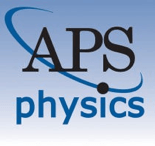
Physical Review X
Empowering Innovation Through Open Access ResearchPhysical Review X is a premier open-access journal published by the American Physical Society, dedicated to advancing the frontiers of knowledge in the field of physics and astronomy. Established in 2011, it has quickly gained recognition for its rigorous peer-review process and high-quality research contributions, achieving an impressive impact factor that solidifies its position in the top quartile (Q1) of its category for 2023. With a Scopus rank of #8 out of 243 in the general physics and astronomy division, it stands in the 96th percentile, showcasing its vital role in disseminating groundbreaking discoveries and theoretical insights across diverse physics domains. As an open-access journal, Physical Review X ensures that research is freely accessible to a global audience, fostering collaboration and innovation. Researchers, professionals, and students alike are invited to explore its extensive archive and contribute to the ongoing dialogue in the scientific community, empowering the next generation of physicists and astronomers.

Ukrainian Journal of Physics
Innovating Insights in the Heart of UkraineUkrainian Journal of Physics, published by the Bogolyubov Institute for Theoretical Physics of the National Academy of Sciences of Ukraine, stands as a significant platform for the dissemination of research in the dynamic field of physics. With its ISSN 2071-0186 and E-ISSN 2071-0194, the journal aims to foster academic dialogue and innovation among researchers, professionals, and students alike. Recognized with a Scopus ranking that places it in the 26th percentile, the journal offers an array of contributions spanning various domains, including general physics and astronomy. Although currently categorized in the Q3 quartile for 2023, it seeks to elevate its scholarly impact while providing open access to its contents, facilitating wider availability and engagement. With a commitment to publishing high-quality research from 2007 to 2024, the journal embraces interdisciplinary approaches to physics, making it an invaluable resource for anyone dedicated to advancing their understanding and exploration of physical sciences.
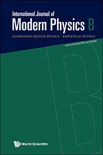
INTERNATIONAL JOURNAL OF MODERN PHYSICS B
Connecting physicists with cutting-edge research and insights.The INTERNATIONAL JOURNAL OF MODERN PHYSICS B, published by WORLD SCIENTIFIC PUBL CO PTE LTD from Singapore, represents a pivotal platform for researchers in the fields of Condensed Matter Physics and Statistical and Nonlinear Physics. With a rich history spanning from 1996 to the present, the journal aims to foster cutting-edge research and innovative theoretical advancements, presenting high-quality peer-reviewed articles that address contemporary challenges in modern physics. Although it operates under a traditional access model, the journal maintains a notable impact, with a commendable ranking within the Scopus metrics – positioning it in the 63rd percentile for Statistical and Nonlinear Physics and the 53rd percentile for Condensed Matter Physics. The Q3 category ranking further underscores its relevance and growing stature in the scientific community. This journal is essential for physicists, researchers, and students seeking to keep abreast of the latest developments and theoretical insights in these dynamic areas of study.
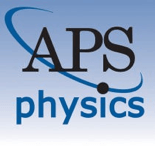
PHYSICAL REVIEW E
Connecting Researchers with Cutting-Edge KnowledgePHYSICAL REVIEW E, published by the American Physical Society, stands as a premier journal in the fields of condensed matter physics, statistical and nonlinear physics, and statistics and probability. With an ISSN of 2470-0045 and an E-ISSN of 2470-0053, this journal prides itself on providing cutting-edge research and insights, contributing significantly to the advancement of knowledge since its inception in 1993. Currently, it boasts a Q1 ranking in Condensed Matter Physics and a Q2 ranking in both Statistical and Nonlinear Physics and Statistics and Probability, highlighting its relevance and impact within these fields. PHYSICAL REVIEW E is particularly renowned for its commitment to disseminating high-quality, peer-reviewed articles that address fundamental questions and emergent phenomena, making it an essential resource for researchers, professionals, and students alike. As it converges years from 1993 to 2024, the journal continues to foster a collaborative environment for innovative research while maintaining accessibility for a global audience.

Jurnal Fizik Malaysia
Connecting Minds, Expanding Horizons in Physics Research.Jurnal Fizik Malaysia is a prominent academic journal dedicated to advancing the field of physics, published by the esteemed Institut Fizik Malaysia. With an aim to foster knowledge dissemination and research collaboration among physicists, the journal serves as a vital platform for original research articles, reviews, and technical notes that cover various sub-disciplines of physics. Although the journal operates under a traditional subscription model, its commitment to quality has been bolstered by a rigorous peer-review process, ensuring high academic standards. Researchers and students in Malaysia and beyond are encouraged to engage with this journal, contributing to a deeper understanding of physical sciences and its applications. Moreover, with its ISSN 0128-0333, Jurnal Fizik Malaysia continues to play a significant role in the scientific community, enhancing visibility and accessibility for local and international research outputs in the ever-evolving landscape of physics.
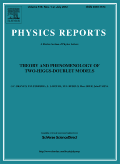
PHYSICS REPORTS-REVIEW SECTION OF PHYSICS LETTERS
Advancing the frontiers of physics knowledge.Physics Reports - Review Section of Physics Letters is a prestigious journal published by Elsevier, dedicated to providing comprehensive and insightful reviews in the field of physics and astronomy. With its ISSN 0370-1573 and E-ISSN 1873-6270, this esteemed publication features high-quality content that spans a converged timeline from 1971 to 2024. Recognized as a Q1 journal in the Physics and Astronomy category for 2023, it holds a remarkable Scopus ranking of #2 out of 243, placing it firmly in the top 1% of its field. The journal serves as a pivotal resource for researchers, professionals, and students alike, facilitating the dissemination of critical analyses and contemporary developments in physics. While it is not open access, its rigorous peer-reviewed articles ensure that students and researchers remain at the forefront of scientific inquiry. With its impactful contributions, Physics Reports continues to enhance the knowledge base and push forward the boundaries of physics research.

Romanian Journal of Physics
Elevating physics discourse to new heights.Welcome to the Romanian Journal of Physics, a distinguished platform dedicated to advancing the field of physics and astronomy since its inception. Published by EDITURA ACAD ROMANE, this journal plays a pivotal role in disseminating high-quality research from Romania and around the globe, with an impressive impact factor that reflects its rigorous academic standards. With a focus on a broad range of topics in general physics and astronomy, it proudly maintains a Q2 ranking in its category for 2023, positioning itself among the top journals in the field. The journal, which has been converging valuable research contributions from 2008 until 2024, is accessible to a wide audience of researchers, professionals, and students interested in the latest developments and discoveries in physics. While it operates under a traditional publication model without Open Access, its commitment to quality research ensures that the contributions featured in its pages resonate well within the scientific community. We invite you to explore the rich findings published in the Romanian Journal of Physics and to engage with the vital discussions shaping the future of physics.
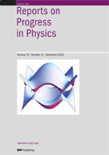
REPORTS ON PROGRESS IN PHYSICS
Illuminating the path of progress in the physical sciences.Reports on Progress in Physics is a prestigious scholarly journal published by IOP Publishing Ltd, based in the United Kingdom. With an illustrious history dating back to 1934, this journal serves as a vital resource for researchers and professionals in the fields of physics and astronomy, offering comprehensive overviews of significant developments in these disciplines. It holds a commendable Q1 classification in both Medicine (miscellaneous) and Physics and Astronomy (miscellaneous) categories, further underscored by its impressive ranking as 4th out of 243 in the general physics and astronomy sector, placing it in the top 2% percentile on Scopus. The journal is dedicated to disseminating high-quality, peer-reviewed articles that facilitate the understanding of complex physical phenomena and their applications. Although it does not currently offer open access options, its rigorous editorial standards ensure that only the most impactful research reaches its wide audience of academics, practitioners, and students, solidifying its role as a cornerstone of knowledge in the physical sciences.